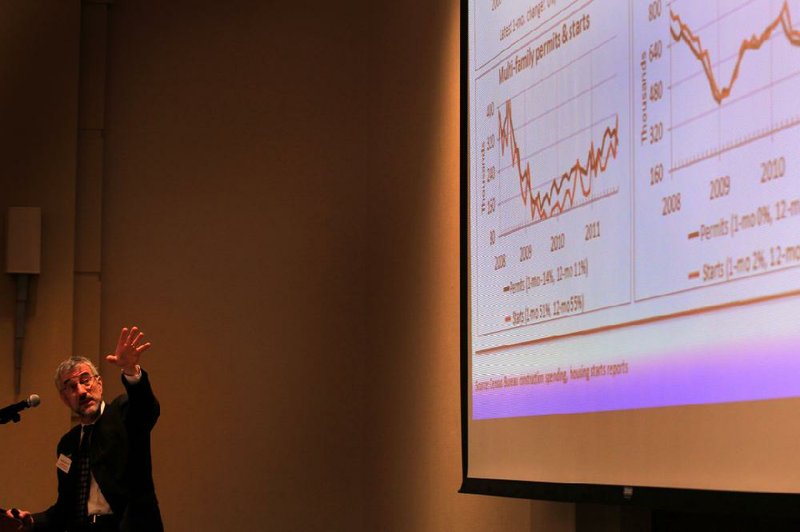LITTLE ROCK — There will be about 10,000 fewer jobs created in Arkansas this year than the U.S. Bureau of Labor Statistics is reporting, Michael Pakko predicted at the annual University of Arkansas at Little Rock economic forecast conference on Wednesday.
Through September, the bureau estimated that Arkansas had added almost 8,000 jobs in the previous 12 months. But Arkansas will actually show a loss of about 1,400 jobs for 2011 compared with 2010 after the annual revision is made in March, Pakko said.
“[The revision] will basically wipe out all the job growth we’ve seen [reported] for the year,” Pakko said to about 100 people at the Doubletree Hotel in downtown Little Rock. “I’m pretty confident we’ll see something at least in that order of magnitude when the numbers are revised.”
The bureau revises employment statistics every year in March using more complete data than it uses throughout the year. Pakko has studied that data to make his forecast.
The change in employment won’t affect Arkansas’ unemployment rate for this year, Pakko said. That’s because the unemployment rate is calculated from another database, a household survey, Pakko said. The employment numbers are based on the nonfarm payroll figures.
“That explains why, despite the fact that we’ve seen fairly strong job growth [reported] since early 2010, that the unemployment rate has been ratcheting up lately,” Pakko said. “This shows that really the employment growth that we’ve been seeing isn’t as rapid as the data have been suggesting. This will leave the unemployment data the way it is, but it will make everything else a little more consistent.” Arkansas’ unemployment rate was 8.3 percent in September, compared with 7.8 percent in January.
“Employment growth has really stagnated in 2011,” said Pakko, chief economist at UALR’s Institute for Economic Advancement.
Pakko has anticipated the bureau’s revision for the past two years.
He first looked ahead at the anticipated revision the federal agency would make for 2009, projecting about 18,000 fewer jobs than originally reported that year.
At the end of 2009, the federal agency reported that Arkansas had lost 20,800 jobs. But when the annual revision came out in March 2010, there actually was a loss of about 40,000 jobs in 2009, close to the 18,000 drop in jobs Pakko had anticipated.
In 2010, the revised numbers were about the same as the Bureau of Labor Statistics had first estimated for Arkansas.
Pakko expects Arkansas to see improvements economically in 2012 and beyond.
Pakko projects Arkansas to have gross domestic product growth this year of 3.1 percent and 3.2 percent in 2012, compared with 2.3 percent in 2010. Gross domestic product is the sum of all goods and services produced in the state.
Pakko expects home sales this year to be about 200 houses short of the number sold in 2010, when about 24,130 homes were sold, based on statistics from the Arkansas Realtors Association. But home sales should be robust next year, Pakko said.
Arkansas should have “slow but steady growth” in taxable sales, including gasoline, next year and in 2013, Pakko said.
Arkansas’ total employment will be about 1.21 million in 2013, back to the peak it hit in 2008, Pakko said.
Kenneth Simonson, chief economist for Associated General Contractors of America, said that the country’s gross domestic product will grow at an annual pace of between 2 percent and 3 percent in the fourth quarter. The gross domestic product grew at an annual rate of 0.4 percent in the first quarter, 1.3 percent in the second quarter and 2.5 percent in the third quarter, though it has not undergone revision.
“[The U.S.] has had more than two years of growth,” Simonson said. “Real gross domestic product has grown now for the ninth-straight quarter. But that growth only added enough to bring us back to where we were when the recession hit at the end of 2007.”
So statistically, the numbers indicate that the recession is far in the past, but “our gut instincts tell us that the recession is as bad as ever,” Simonson said.
“So this has led to tremendous distrust and dissatisfaction with the state of government and with policy,” Simonson said.
Simonson projects that gross domestic growth will be about 3 percent next year. He expects the national unemployment rate, which is currently 9.1 percent, to fall to 8 percent by December 2012.
And inflation next year will be about 2 percent, Simonson said.
Business, Pages 25 on 11/03/2011
